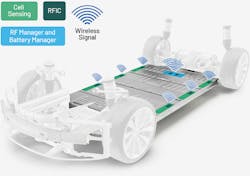Analog Devices Introduces Wireless Battery Management System for EVs
Analog Devices, Inc. (ADI) recently introduced a wireless battery management system (wBMS) that provides automotive manufacturers increased flexibility to scale their electric vehicle (EV) fleets into volume production across a wide range of vehicle classes. The company claims this is the first wireless battery management system available for production EVs. It will debut on General Motors' production vehicles powered by Ultium batteries.
The implementation of the ADI's wBMS eliminates the traditional wired harness, saving up to 90% of the wiring and up to 15% of the volume in the battery pack, while also improving design flexibility and manufacturability, without compromising range and accuracy over the life of the battery.
The ADI's wBMS includes all integrated circuits, hardware, and software for power, battery management, RF communication, and system functions in a single system-level product. It supports ASIL-D safety and module-level security, building upon the ADI's BMS battery cell measurement technology. By delivering high accuracy for the lifetime of the vehicle, the system enables maximum energy use per cell required for best vehicle range and supports safe and sustainable zero-cobalt battery chemistries, such as lithium iron phosphate (LFP).
Additional system features enable batteries to measure and report their own performance, increasing early failure detection, and enabling optimized battery pack assembly. The data can be monitored remotely throughout the battery lifecycle — from assembly to warehouse and transport through installation, maintenance, and into a second-life phase.
The ADI and General Motors announced a collaboration, bringing the ADI's wBMS technology to General Motors' Ultium battery platform. The ADI technology helps ensure scalability of the Ultium platform across General Motor's future lineup, which will encompass different brands and vehicle segments, from work trucks to performance vehicles.
"The transition of battery packs from wired to wireless connectivity enables automotive manufacturers to scale their EV platforms across multiple vehicle models to meet growing consumer demand," said Patrick Morgan, vice president, automotive at the ADI. "Our wBMS solution not only simplifies manufacturing but also allows new systems to be built on wireless data, accelerating the entire industry toward a sustainable future. We are honored to bring this breakthrough system innovation to market with General Motors."
"We are pleased to collaborate with the ADI to take the wBMS technology to production as part of our ground-breaking Ultium battery platform," said Kent Helfrich, executive director, global electrification and battery systems at General Motors. "The ADI's wBMS technology enables the more widespread electrification of our fleet and we look forward to a continued collaboration with the ADI to deliver innovation in safety, quality, and performance for the future."
For more information, visit here.
